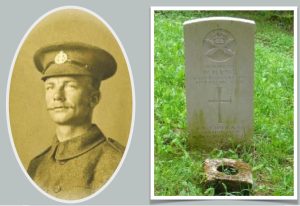11th company, Machine Gun Corps (Infantry)

William Henry Davis was born at Eastcombe, near Stroud in 1886, the son of Robert and Annie Davis. Robert was a ‘stick finisher’ – someone who mounted decorative fixings onto walking sticks. The 1911 census shows the couple had nine children, of whom eight were still living at that time. The family lived at Hill House, Bussage.
Unfortunately William’s Army Service Record has not survived and was likely to have been destroyed in 1940 during the German bombing of London. However, we do know that he joined the Army before the First World War (probably in about 1906) and the 1911 census confirms that he was a Rifleman with the 2nd Battalion, Rifle Brigade, based in India. His number was 1584.
Following the outbreak of war on 4 August 1914 the 2nd Battalion, Rifle Brigade was ordered to return to the UK and they sailed from Bombay on 29 September 1914, arriving at Liverpool on 22 October 1914. They were sent to Hursley Park, Winchester, to join the 25th Brigade of 8th Division
and sailed to Le Havre, France on 7 November 1914.
The unit was soon in action and participated in the Moated Grange Attack at Neuve Chapelle before fighting died down for the winter.
They were in action several times during 1915: from 10 to 13 March, once more at Neuve Chapelle and on 9 May 1915 during an attack at Fromelles and on 25 September in the attack at Bois Grenier.
It appears likely that Rifleman Davis (number 1584) was a member of one of the two machine gun section within his battalion. In October 1915 the Machine Gun Corps was formed and men and guns were taken from their battalions and regiments and placed into Companies within the newly formed Corps.
On 1 January 1916 Davis was one of 25 men of the 1st and 2nd Rifle Brigade who transferred, while in France, into 11 Company, within 4th Division. He was given a new number of 18008.
On 1 July 1916 4th Division was heavily involved in the infamous ‘first day of the Battle of the Somme’, the blackest day in the history of the British Army, when it suffered almost 60,000 casualties, about 20,000 killed. Fourth Division went into action over the hilly ground between the villages of Serre and Beaumont Hamel, no ground was gained and it suffered 4,692 casualties killed, wounded and missing.
William Davis almost certainly received a gun shot wound to his right knee in this action and eventually arrived at 2nd General Hospital, Le Havre. A report in the Stroud News of July 1916 states: ‘in the recent great advance he was struck by shrapnel whilst working a machine gun’. He was then sent back to the UK for treatment to a hospital in the Portsmouth area. Such was the severity of the lacerations it was necessary to amputate one of his legs and his parents were summoned by telegram to visit him. The arrived too late, as he died on 10 July 1916, aged 30.
At that time families had a choice of arranging burial near to the place of death or to bring the body home for a local burial. They could also have the grave marked by a Commonwealth War Graves Commission (CWGC) headstone (at public expense and which would be maintained by them) or pay for their own headstone. The Davis family paid for their own headstone. Over the years this deteriorated and in 2006, although not obliged to do so, the CWGC commissioned one of their standard headstones to be placed on the grave, to ensure that this casualty of the First World War continued to be properly commemorated. His name appears on the Eastcombe War Memorial.
Mr and Mrs Davis had four sons in the Army and two sons-in-law had already fallen in action (Private Arthur Hook, 7 Glosters and Private Walter Fern, 1st Glosters, whose wife, Frances was the eldest daughter of Robert and Annie).
Research by Graham Adams 5 January 2015 (revised) with thanks to Graham Sacker for the bulk of the research — also certain information obtained from ‘They Answered their Country’s Call – The War Dead of Bisley, Eastcombe & Oakridge’ by Nick Thornicroft, as published in The Great War Magazine January 2015.
